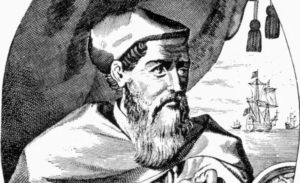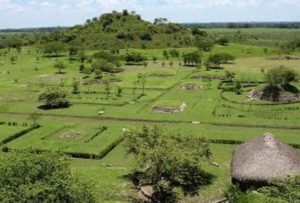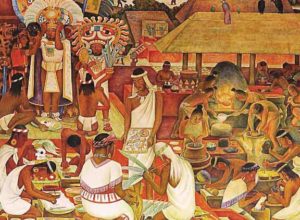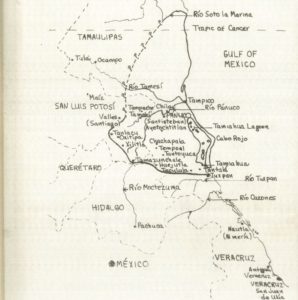Podcast: Play in new window | Download
Subscribe: Apple Podcasts | RSS
 It was the fall of 1497. Florentine navigator Amerigo Vespucci had come ashore in a strange land he would later call the New World. In a letter to a politician in Florence named Piero Soderini, the explorer and merchant sailing for Spain called this place Lariab. This strange-sounding name came from Vespucci’s brief interactions with the natives on shore. In his letter to Soderini he described a lush and abundant place full of people, animals and ample supplies of fruits and vegetables located near the Tropic of Cancer, the 23rd parallel. This would have put him on the Gulf Coast of the modern Mexican state of Tamaulipas, the very first European to land on the Mexican mainland. No one knows how long Vespucci stayed in Lariab but he returned to Spain in October of 1498. All the evidence that historians have of this voyage is Vespucci’s letter to the Florentine politician and a map drawn up in 1500 attributed to the navigator showing a detailed depiction of the Gulf of Mexico. Some scholars dispute that the voyage ever took place, but there are certain clues in the letters indicating that Vespucci made it to the shores of Mexico before any other European. For one, the name of the region, Lariab, ends in -ab like many other indigenous place names in Tamaulipas based in the Huastec language, a northern offshoot of the Maya. The Florentine navigator also described the people he found in Lariab as mostly devoid of clothing, not even using small breechcloths covering up the “private areas.” Later Spanish explorers described the same thing among the natives of the Tamaulipas gulf coast. It may have been Vespucci’s description of the territory – especially the high number of people living there – that would fuel two more voyages to the area before Cortés even made landfall in Mexico to later conquer the Aztecs. Also, the later expeditions were met with immediate hostility from the local indigenous population, which may have indicated somewhat recent and possibly heavy-handed contact with Europeans. The area known as Lariab to the local indigenous people would soon be called Pánuco by the invading Spanish and would play an important but nearly forgotten role in early Spanish colonial history in the Americas.
It was the fall of 1497. Florentine navigator Amerigo Vespucci had come ashore in a strange land he would later call the New World. In a letter to a politician in Florence named Piero Soderini, the explorer and merchant sailing for Spain called this place Lariab. This strange-sounding name came from Vespucci’s brief interactions with the natives on shore. In his letter to Soderini he described a lush and abundant place full of people, animals and ample supplies of fruits and vegetables located near the Tropic of Cancer, the 23rd parallel. This would have put him on the Gulf Coast of the modern Mexican state of Tamaulipas, the very first European to land on the Mexican mainland. No one knows how long Vespucci stayed in Lariab but he returned to Spain in October of 1498. All the evidence that historians have of this voyage is Vespucci’s letter to the Florentine politician and a map drawn up in 1500 attributed to the navigator showing a detailed depiction of the Gulf of Mexico. Some scholars dispute that the voyage ever took place, but there are certain clues in the letters indicating that Vespucci made it to the shores of Mexico before any other European. For one, the name of the region, Lariab, ends in -ab like many other indigenous place names in Tamaulipas based in the Huastec language, a northern offshoot of the Maya. The Florentine navigator also described the people he found in Lariab as mostly devoid of clothing, not even using small breechcloths covering up the “private areas.” Later Spanish explorers described the same thing among the natives of the Tamaulipas gulf coast. It may have been Vespucci’s description of the territory – especially the high number of people living there – that would fuel two more voyages to the area before Cortés even made landfall in Mexico to later conquer the Aztecs. Also, the later expeditions were met with immediate hostility from the local indigenous population, which may have indicated somewhat recent and possibly heavy-handed contact with Europeans. The area known as Lariab to the local indigenous people would soon be called Pánuco by the invading Spanish and would play an important but nearly forgotten role in early Spanish colonial history in the Americas.
 By the early 1500s the Caribbean Sea had turned into a Spanish lake. The Spaniards had colonized Cuba, Hispaniola, Jamaica and Puerto Rico and had trading posts and small garrisons on some of the smaller surrounding islands. There was a lot of activity in the Caribbean in the first few decades of the 1500s. Spanish explorers had charted the northern coast of South America and had skirted the southern part of Central America. A few ships had blown off course to the Yucatán. By the year 1516 the governor of Cuba, Diego de Velásquez started planning formal expeditions that would go due west from his island. Whether he knew of Vespucci’s discovery or had heard of others visiting the gulf coast of what is now Mexico is unknown, but he suspected at least that there was a great unexplored landmass to be found if one just sailed west. So, in 1517 he sent the first of two expeditions to find new lands and new sources of wealth to the west of Cuba. Francisco Hernández de Córdoba headed the first voyage, with one ship, and made landfall in the Yucatán. He traveled part of the length of the peninsula, made landfall several times to trade with the locals, and returned to Cuba with enough gold and other objects of value to warrant another expedition to the mainland. In 1518, Juan de Grijalva commanded 4 ships and 200 men for a second voyage, this one broader and more ambitious. As Governor Velásquez of Cuba did not have permission from the Spanish King to settle or formally exploit newly discovered lands, this expedition like the first one under Córdoba was one of exploration not of colonization. From May until mid-June of 1518, Grijalva skirted the coast of the Yucatán and sailed in the waters of the modern Mexican states of Tabasco and Veracruz. On June 24, 1518, near the present-day city of Veracruz, Grijalva sent one of the ships back to Cuba. The ship was commanded by Pedro de Alvarado, a man who would pop up many times throughout colonial Mexican history, and his caravel took back to Cuba the gold and other precious items thus accumulated on the trip along with sick sailors in need of medical attention. Grijalva continued along the coast and somewhere near Cabo Rojo in the northern part of the modern Mexican state of Veracruz he encountered a fleet of hostile natives in canoes trying to attack his ships. Musket fire dispersed the armada of canoes. Grijalva eventually made landfall north of the attack and interacted with local Huastecs.
By the early 1500s the Caribbean Sea had turned into a Spanish lake. The Spaniards had colonized Cuba, Hispaniola, Jamaica and Puerto Rico and had trading posts and small garrisons on some of the smaller surrounding islands. There was a lot of activity in the Caribbean in the first few decades of the 1500s. Spanish explorers had charted the northern coast of South America and had skirted the southern part of Central America. A few ships had blown off course to the Yucatán. By the year 1516 the governor of Cuba, Diego de Velásquez started planning formal expeditions that would go due west from his island. Whether he knew of Vespucci’s discovery or had heard of others visiting the gulf coast of what is now Mexico is unknown, but he suspected at least that there was a great unexplored landmass to be found if one just sailed west. So, in 1517 he sent the first of two expeditions to find new lands and new sources of wealth to the west of Cuba. Francisco Hernández de Córdoba headed the first voyage, with one ship, and made landfall in the Yucatán. He traveled part of the length of the peninsula, made landfall several times to trade with the locals, and returned to Cuba with enough gold and other objects of value to warrant another expedition to the mainland. In 1518, Juan de Grijalva commanded 4 ships and 200 men for a second voyage, this one broader and more ambitious. As Governor Velásquez of Cuba did not have permission from the Spanish King to settle or formally exploit newly discovered lands, this expedition like the first one under Córdoba was one of exploration not of colonization. From May until mid-June of 1518, Grijalva skirted the coast of the Yucatán and sailed in the waters of the modern Mexican states of Tabasco and Veracruz. On June 24, 1518, near the present-day city of Veracruz, Grijalva sent one of the ships back to Cuba. The ship was commanded by Pedro de Alvarado, a man who would pop up many times throughout colonial Mexican history, and his caravel took back to Cuba the gold and other precious items thus accumulated on the trip along with sick sailors in need of medical attention. Grijalva continued along the coast and somewhere near Cabo Rojo in the northern part of the modern Mexican state of Veracruz he encountered a fleet of hostile natives in canoes trying to attack his ships. Musket fire dispersed the armada of canoes. Grijalva eventually made landfall north of the attack and interacted with local Huastecs.
 The Huastecs living in the northern gulf territories that the Spanish would later call Pánuco are a northern offshoot of the Maya. Archaeologists, anthropologists and linguists have studied the Huastecs to try to solve the mystery as to why this distinct Maya people lived hundreds of miles away from the Maya heartland. Some researchers believe that early Maya culture extended this far north into the modern Mexican states of Veracruz and Tamaulipas. Others believe that the Huastecs represent a lost Maya colony established far away from the magnificent jungle cities of the Yucatán that managed to survive many centuries after its founding. The Huastecs the Spanish encountered in Pánuco were organized into over a dozen small kingdoms that peacefully coexisted with one another. The Huastecs were an agriculture-based civilization and grew an abundance of crops in the fertile soils found throughout the region. Main Huastec towns had the hallmarks of typical high civilizations of Mesoamerica: pyramids, temples, elite residences of the upper classes and other elaborate stone structures. The Huastec kings and other members of the nobility flattened their foreheads, wore bright feathers of tropical birds, slathered themselves in silver jewelry and dyed their hair various colors which all seemed shocking to the Spanish. While the common people usually did not wear any clothing, ironically one of the major plants cultivated by the Huastecs was cotton and they wove beautiful pieces of cloth that were traded throughout ancient Mexico. They made a special shawl or wrap which the Aztecs called a centzontilmatli, which meant “mantle of a thousand colors.” While they had trading contact with the Aztec Empire, the independent Huastec kingdoms never came under Aztec domination. The Huastecs would unite to combat all outside aggressors whether they be the expansionistic Aztecs from their southeastern flank or the raiding Chichimecas from the north. The Huestecs were very skilled in warfare and unlike other Mesoamerican peoples they enslaved their captives in war instead of sacrificing them. In fact, human sacrifice did not exist in Huastec culture. For the most part, though, since they got along with each other and outside threats were few and far between, the Huastecs lived in relative peace and abundance. Because of this abundance and peace in the region, the population of Pánuco was very high when the Spanish first arrived. This meant trouble for the Huastecs.
The Huastecs living in the northern gulf territories that the Spanish would later call Pánuco are a northern offshoot of the Maya. Archaeologists, anthropologists and linguists have studied the Huastecs to try to solve the mystery as to why this distinct Maya people lived hundreds of miles away from the Maya heartland. Some researchers believe that early Maya culture extended this far north into the modern Mexican states of Veracruz and Tamaulipas. Others believe that the Huastecs represent a lost Maya colony established far away from the magnificent jungle cities of the Yucatán that managed to survive many centuries after its founding. The Huastecs the Spanish encountered in Pánuco were organized into over a dozen small kingdoms that peacefully coexisted with one another. The Huastecs were an agriculture-based civilization and grew an abundance of crops in the fertile soils found throughout the region. Main Huastec towns had the hallmarks of typical high civilizations of Mesoamerica: pyramids, temples, elite residences of the upper classes and other elaborate stone structures. The Huastec kings and other members of the nobility flattened their foreheads, wore bright feathers of tropical birds, slathered themselves in silver jewelry and dyed their hair various colors which all seemed shocking to the Spanish. While the common people usually did not wear any clothing, ironically one of the major plants cultivated by the Huastecs was cotton and they wove beautiful pieces of cloth that were traded throughout ancient Mexico. They made a special shawl or wrap which the Aztecs called a centzontilmatli, which meant “mantle of a thousand colors.” While they had trading contact with the Aztec Empire, the independent Huastec kingdoms never came under Aztec domination. The Huastecs would unite to combat all outside aggressors whether they be the expansionistic Aztecs from their southeastern flank or the raiding Chichimecas from the north. The Huestecs were very skilled in warfare and unlike other Mesoamerican peoples they enslaved their captives in war instead of sacrificing them. In fact, human sacrifice did not exist in Huastec culture. For the most part, though, since they got along with each other and outside threats were few and far between, the Huastecs lived in relative peace and abundance. Because of this abundance and peace in the region, the population of Pánuco was very high when the Spanish first arrived. This meant trouble for the Huastecs.
When the Grijalva expedition returned to Cuba, the governor was disappointed. He expected more riches and a more productive trip overall. Grijalva fell out of favor with the governor and the next voyage to the coast of Mexico would be headed by none other than Hernán Cortés. This would be the legendary expedition that would eventually lead to the encounter with and conquest of the Aztec Empire. Cortés landed on the coast of Mexico in early 1519 and founded the city of Veracruz. Because he had heard of the rich Huastec kingdoms to the north of his new settlement, he sent Francisco de Montejo north to Pánuco with 50 men in 2 small ships. This side trip took 21 days and although the details of the voyage are lost to history, Cortés would later use the Montejo expedition to lay claim to Pánuco which was already being claimed by the wealthy and ambitious Spanish governor of Jamaica, Francisco de Garay.
 Governor Garay, who had sailed with Christopher Columbus on his second voyage to the New World, had made a fortune in the Spanish colonies of the West Indies through owning gigantic pig farming operations. It took him 5,000 native slaves just to tend to all the pigs. Garay went to Spain to try to secure more indigenous slaves through the colonial repartimiento system, but the king would grant him no more. Garay had his eyes on new lands and new sources of labor to the west. After he had heard about the governor of Cuba’s expeditions to the Mexican mainland Garay organized one of his own headed by a man named Alonso Alvarez de Pineda. Pineda started in Florida in early 1519 and headed west along the gulf coast. He stopped in several places along the way and one of them was Pánuco. By the time Pineda got to Veracruz, Cortés had already started marching inland with the objective of reaching the capital city of the Aztec Empire, Tenochtitlán. Knowing of Garay’s intentions and fearing that Pineda was making a case for Governor Garay’s administration of Pánuco, Cortés turned back to meet with Pineda at Veracruz. Pineda wanted to establish a boundary between what Cortés had already claimed and what he had discovered for the governor of Jamaica on his months-long sea voyage. Cortés would not bargain. Cortés left for the interior while Pineda returned north to Pánuco to repair his ships, gather provisions and possibly set up a small colony. Pineda mapped out a perfect location for a future Spanish settlement somewhere near modern-day Tampico, Tamaulipas on the Pánuco River and returned to Jamaica to relay his findings and other news to Governor Garay. After meeting with Pineda the Jamaican governor did two things. First, he sent emissaries to the Spanish court to secure royal licenses to colonize Pánuco. At the same time, he also sent Pineda back to Pánuco to establish a colony there to further solidify his claim on the region. Governor Garay knew the colony would not be self-sustaining for the first year or so, so he arranged to have supplies sent to Pánuco once a month. The Pineda colony would not last long. After a few months it was attacked by a group of Huastecs which had united from various Huastec kingdoms. Pineda and many of his men were killed and those who managed to survive boarded the remaining ships and sailed to Veracruz.
Governor Garay, who had sailed with Christopher Columbus on his second voyage to the New World, had made a fortune in the Spanish colonies of the West Indies through owning gigantic pig farming operations. It took him 5,000 native slaves just to tend to all the pigs. Garay went to Spain to try to secure more indigenous slaves through the colonial repartimiento system, but the king would grant him no more. Garay had his eyes on new lands and new sources of labor to the west. After he had heard about the governor of Cuba’s expeditions to the Mexican mainland Garay organized one of his own headed by a man named Alonso Alvarez de Pineda. Pineda started in Florida in early 1519 and headed west along the gulf coast. He stopped in several places along the way and one of them was Pánuco. By the time Pineda got to Veracruz, Cortés had already started marching inland with the objective of reaching the capital city of the Aztec Empire, Tenochtitlán. Knowing of Garay’s intentions and fearing that Pineda was making a case for Governor Garay’s administration of Pánuco, Cortés turned back to meet with Pineda at Veracruz. Pineda wanted to establish a boundary between what Cortés had already claimed and what he had discovered for the governor of Jamaica on his months-long sea voyage. Cortés would not bargain. Cortés left for the interior while Pineda returned north to Pánuco to repair his ships, gather provisions and possibly set up a small colony. Pineda mapped out a perfect location for a future Spanish settlement somewhere near modern-day Tampico, Tamaulipas on the Pánuco River and returned to Jamaica to relay his findings and other news to Governor Garay. After meeting with Pineda the Jamaican governor did two things. First, he sent emissaries to the Spanish court to secure royal licenses to colonize Pánuco. At the same time, he also sent Pineda back to Pánuco to establish a colony there to further solidify his claim on the region. Governor Garay knew the colony would not be self-sustaining for the first year or so, so he arranged to have supplies sent to Pánuco once a month. The Pineda colony would not last long. After a few months it was attacked by a group of Huastecs which had united from various Huastec kingdoms. Pineda and many of his men were killed and those who managed to survive boarded the remaining ships and sailed to Veracruz.
In late 1520 word reached Cortés in central Mexico of the disaster in Pánuco and that the Pineda colony sponsored by the Governor of Jamaica had been abandoned. He saw this as an opportunity to claim Pánuco as his own. He sent Spanish troops and native allies to Pánuco to subdue the region and managed to get the local kings to swear allegiance to the Spanish Crown. The next year, though, in 1521, Governor Garay had gotten the royal licenses necessary from the King of Spain to colonize and exploit the Pánuco region. So, Pánuco did not belong to Cortés, the man responsible for its submission, it belonged to the governor of Jamaica who had played politics in Europe in order to get what he wanted. In addition to being an abundant region, rumors abounded at the time of “another Tenochtitlán” existing somewhere to the north of Pánuco, so whoever controlled Pánuco could easily mount an expedition to this far-off wealthy kingdom of legend and conquer it for himself. While Garay had the technical legal title to Pánuco, Cortés was “boots on the ground” in the region and had no idea what was going on in Spain. In 1522 Cortés founded a town called Villa Pánuco or Santisteban del Puerto near the ancient Huastec city of Chila. The Huastecs revolted and the Spanish and native allies put down all rebellions. News of Cortés’ exploits reached Spain and on April 24, 1524, the Spanish king gave Cortés full rights over Pánuco. This included the right to form encomiendas, or farms and ranches with native slave labor attached. The abundance of people in Pánuco previously mentioned made the area quite a prize to anyone who could secure these encomienda labor rights. While many Huastecs were forced into labor on local ecomiendas, a great number of them were also taken from Pánuco to work the plantations on the Spanish Caribbean islands. By the mid-1520s the native Arawak and Carib peoples who were indigenous to the islands were dying out from overwork and disease and needed to be replaced. Pánuco filled that need, as the governor of Jamaica had foreseen. For a solid 10 years, slave ships left the ports of Pánuco bound for the slave markets of Puerto Rico, Hispaniola, Jamaica and Cuba. Ironically, the abundant human resources that attracted the Spanish to Pánuco, among other things, was the cause of its demise. Because of the forced drain of the native population to fill the labor needs of the Caribbean plantations there were not enough natives left behind to do the work to keep Pánuco the prosperous and abundant land it once was. Within another decade or so, this once rich area was a backwater of the Spanish Empire. The region never recovered.
REFERENCES
Chipman, Donald E. History of the Province of Pánuco in New Spain, 1518-1533. Albuquerque: University of New Mexico Press, 1962.

2 thoughts on “Pánuco, Forgotten Spanish Colony in Mexico”
Proudly born in these beautiful land of Panuco, Veracruz. Thank you for this beautiful story of my Huasteca Veracruz land.
Orgullosamente nacido en estas hermosa tierra de Panuco, Veracruz Gracias por este hermoso relato de historia e mi tierra huasteca veracruzana.
So, did Rodrigo Ranjel stay in Panuco when the survivors of the De Soto trip ended?
I am very interested in going to Panuco. Please write to me.
cliffordcope@yahoo.com